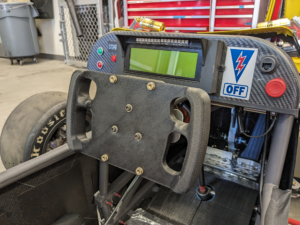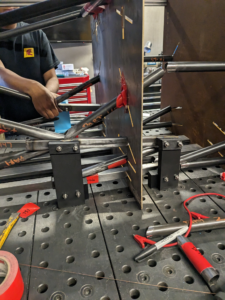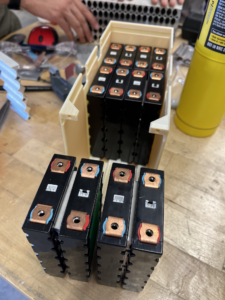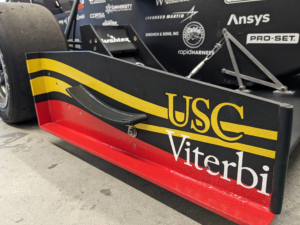Blogs & News
- Category: Technical Education
- DATE: November 6, 2024
Racing Against Time: USC Engineering Student Racing Teams Maximize Speed and Efficiency with 3D Printing
“Lost time is never found again.” Those words are attributed to Benjamin Franklin, one of America’s founders, known for his inventiveness and innovative ideas. In a modern context, they highlight a simple truth: time is a non-renewable resource that shouldn’t be squandered. But while we still have the same number of hours in a day as Franklin, current technology helps us be more time-efficient, allowing us to do complex things more quickly and move to the next productive endeavor.
That truth is no stranger to the students that make up the University of Southern California’s Formula SAE race teams. As part of an annual international collegiate competition, their task is to design, build, and field a race car within a short time window and with limited resources. USC Racing focuses on internal combustion engine cars, while SC Formula Electric specializes in electric vehicles. For these student teams, additive manufacturing (AM) technology is a tool they lean on heavily to give their cars the best chance at the winner’s circle and maximize their time to make that happen.
Benefits of Additive Manufacturing Technology
Demonstrating their belief in the benefits of AM technology, USC Racing’s 2024 car embodies about 40 3D printed parts. According to Lucas Dudley, the team’s chief engineer, that’s up from five on the 2023 car, a 700% increase. Some of the 3D printed components include the steering wheel (shown in the photo below), made from FDM® Nylon 12CF carbon-fiber material, circuit board enclosures, and aerodynamic elements, to name just a few.
Dudley is quick to emphasize the time benefits AM provides, noting the aerodynamic components as a specific example. “As we generate more and more complicated designs, there are some elements that become prohibitively challenging to manufacture out of composites, and they’re at the scale where 3D printing is a more competitive application,” says Dudley. “The manufacturing time goes down to near zero, and for us, that is a big thing because we’re running on limited time,” he adds. To be more specific, the students report that their time is the most precious and limited resource, since the majority is spent manufacturing when they’re not in the classroom.
INFLUENCING & OPTIMIZING DESIGN
When asked how AM influences the team’s design philosophy, Dudley cites two factors: rapid prototyping and design-for-manufacturing. AM is a clear winner for minimizing the time to optimize the car’s component designs. It allows the engineers to test a design on a physical prototype and quickly change it if necessary.
Dudley points to the car’s front wing whiskers (shown in photo below) as an example where AM provided a fast resolution: “We designed an initial version, mounted it, and noticed the design error. Within 24 hours, we had a second revision, and that was what went on the car,” says Dudley. “If you design it incorrectly the first time – which is a reality of being an engineer, and a student engineer in particular – the rapid prototyping element is very helpful,” he adds.
Dudley’s point about design-for-manufacturing highlights a fundamental benefit of AM: the capacity to produce virtually any geometry. This capability liberates the team from the constraints of designing for conventional manufacturing. “Our creative freedom in the design process is so much larger than it was in the past. It really allows us to answer the question of design intent and what it is we want to do, not what we are bound by with the traditional constraints of manufacturing,” Dudley says.
3D Printed Tooling
3D printed tooling is another application the USC race teams leverage to produce cars under tight production schedules. PJ Morgan, chief engineer of SC Formula Electric, the electric race car competition, praises AM for its ability to avoid the time and cost constraints of machined tooling. “We definitely take advantage of a lot of the tooling we can make. With metal tools alone, you’re limited in what you can do.”
(Photo: 3D printed intake components)
“There’s a lot more creative freedom (with AM),” Morgan says. He credits the precision of 3D printed jigs for accurately integrating the car’s suspension and wheels into the frame. AM’s design freedom turns what would be a very challenging tooling setup into a much more straightforward exercise while ensuring the necessary accuracy. “The 3D printed suspension mount jigs save time and money as well as improve the build quality,” says Morgan, adding that 3D printing the jigs is far faster and more accommodating of complex designs than traditional manufacturing. In a similar tooling application, Morgan’s team used a 3D printed jig to assemble the car’s steering components. Morgan adds, “For our steering rack, we used a 3D printed jig to hold all the tubes in place for welding. There’s just no way to hold that with any machined piece for any reasonable amount of money.”
(Photo: 3D printing lets the team create accurate welding and assembly fixtures)
FDM MATERIAL CAPABILITIES
Morgan also highlights FDM technology’s material capabilities as a valuable benefit. The car’s electrical power source, called an accumulator, holds multiple battery modules separated by enclosures called segments. Each segment has to be heat-resistant and non-conductive. To meet that challenge, Morgan’s team printed the segments using ULTEM™ 1010 resin, a high-performance polymer that resists conductivity and is very heat resistant.
“Each of our battery segments is surrounded by an ULTEM™ 1010 resin box, and that’s been essential for our accumulator design,” says Morgan. But before finalizing the design, the students used AM’s rapid prototyping capabilities using lower-cost ABS material to ensure the fit and form were correct before printing with the ULTEM™ material. Morgan adds, “If we didn’t have access to ULTEM™ 1010 resin to make our accumulator, it would have been really rough trying to find materials that are heat-resistant and not conductive enough to accomplish that design.”
(Photo: The accumulator module with sections printed using ULTEM 1010 resin)
Time Efficient Alternative to traditional manufacturing
The common thread among these AM solutions is the time-saving element. Reflecting on the value of AM, Lucas Dudley echoes that belief. “It’s an incredibly time-efficient process. It’s a complete lights-out operation. An engineer that would have been machining a part can now be doing their job as an engineer, designing more parts,” Dudley says.
Whether it’s tomorrow’s engineers tackling a university project or today’s engineers solving problems on the factory floor, one fact is clear: additive technology offers them a more time-efficient alternative to traditional manufacturing. This has been proven countless times. But what about cost – how does AM impact the bottom line? To cite another Benjamin Franklin quote: “Time is money.” Put simply, in business, when you save time, you save money, too. USC’s time-constrained student race teams are learning that firsthand, thanks to their exposure to additive manufacturing. It’s knowledge that will serve them well in their post-university careers.

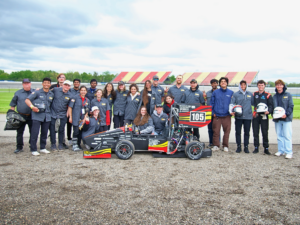
Article was written and copyrighted by Stratasys.
H2I GROUP & STRATASYS
With a primary focus on education technology in design, prototyping, advanced manufacturing, and fabrication, you can count on H2I Group’s technical education team to deliver exceptional technical education products and STEM solutions that both enhance the learning experience and support educators. This includes everything from starter-level to industry-advanced equipment, like Stratasys 3D printers and materials. In addition to being a full-service supplier of quality technical education products and solutions, we also offer expert design assistance, budgeting support, coordination with other trades, installation, and on-site service and maintenance to help make your vision a reality.
Our vendor partner, Stratasys, has been at the forefront of 3D printing innovation for more than 30 years. Stratasys 3D printing technology is fueling the next generation of innovation in the areas of aerospace, automotive, and education.
Contact us to learn more about Stratasys and the 3D printing products and solutions we provide.
USC Webinar
Join us for an in-depth webinar and hear from the USC racing team. Learn how these students have scaled from five to over forty 3D-printed parts in their latest car, optimizing components like steering wheels and aerodynamic features with Stratasys’ FDM® Nylon 12CF carbon fiber and ULTEM™ 1010 resin.
recent blogs


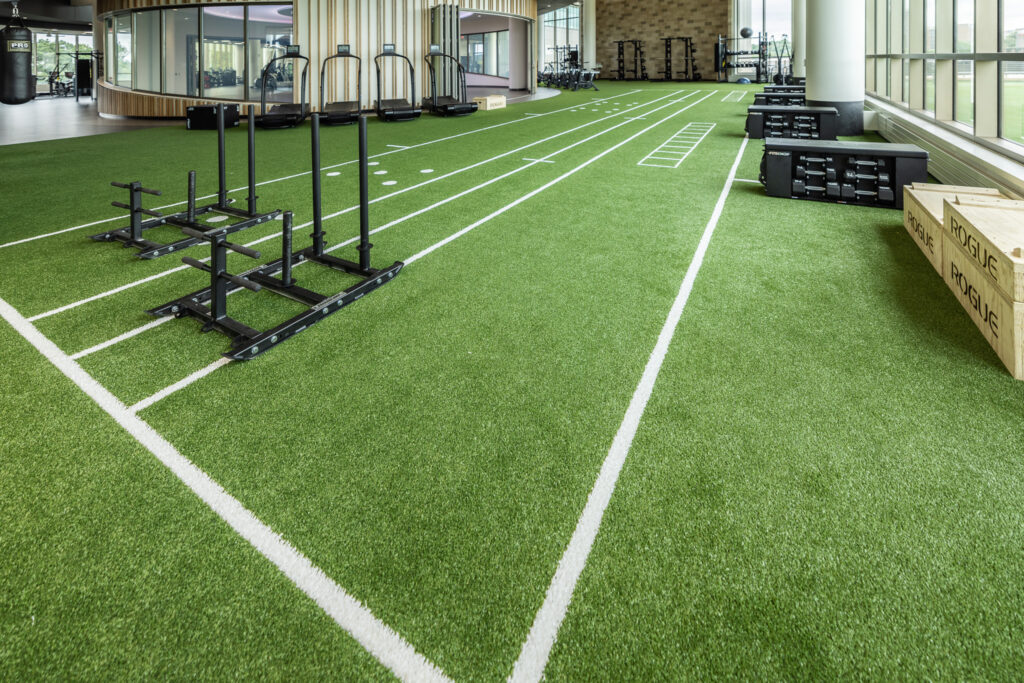
GET STARTED
LET’S TALK ABOUT YOUR PROJECT TODAY
Are you in need of expert guidance for your building project? H2I Group’s experienced professionals are here to assist you with any questions or concerns you may have. Contact us today to learn more about our services and how we can help you achieve your goals.
